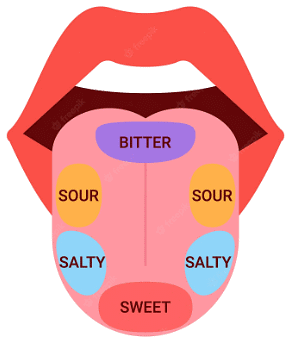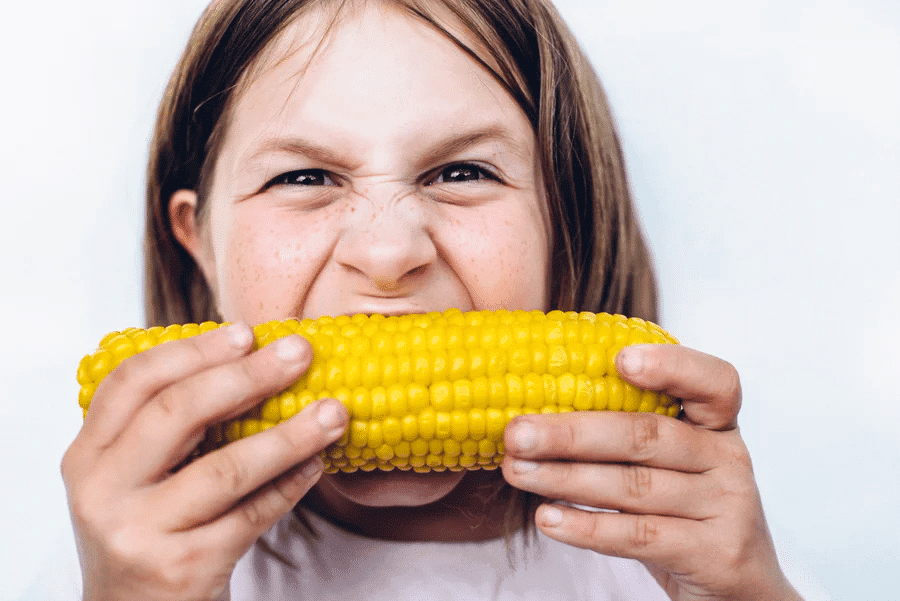From Tasting to Digesting Class 5 Notes EVS Chapter 3
| Table of contents |

|
| Different Tastes |

|
| Closing Your Eyes and Tell |

|
| Chew it or Chew it Well: What’s the difference? |

|
| Straight from the Heart |

|
| Good Food, Good Health |

|
Different Tastes
We eat different types of food items that have different tastes and smells. The taste of some food items is pleasing while the taste of several other food items irritates us. We do not like to eat food items that have the same taste again and again because we get bored of the same taste over time.
Here are different food items and their taste:
- Food items having sweet taste:Sugar, Kheer, Jalebi, Gulab Jamun, Apple, Banana, Jaggery etc.
- Food items having salty taste: Samosa, Dal, Chicken, Meat, Cooked Vegetables, Aalu Bhujia, Fried peanuts.
- Food items having sour taste: Citrus fruits, Tamarind (imli), Gooseberries, Cranberries, Grapes, Kiwi, Apples.
- Food items having bitter taste: Bitter gourd, Broccoli, Citrus peel, Cocoa, Coffee, Beer, Red wine.
- Food items having pungent taste: Chilies, Garlic, Ginger, Hot peppers and Onions etc.

Closing Your Eyes and Tell
- We can tell about various food items without seeing them. We identify different food items by just tasting them or smelling them.
- We taste the food item with the help of our tongue. Our tongue has a rough surface due to tiny bumps on it.
- These tiny bumps on the tongue are called taste buds and help us in tasting different food items.
How do we taste food?
- When we put a food item in our mouth, the saliva on our tongue mixes with the food item and after that reaches taste buds and we get to know the taste of the food item.
- If we wipe the front part of the tongue and make it dry and then put a food item on it, we will not able to get the taste of the food item because the taste does not reach the taste buds.
Different Parts of Tongue and Taste they Identify
 Parts of Tongue
Parts of Tongue
- The front end of our tongue tastes sweet and salty food items.
- Theside partsof our tongue identify the taste of sour food items.
- The back endof the tongue identifies the taste of bitterfood items.
Chew it or Chew it Well: What’s the difference?
The food that we eat goes into our stomachs through the food pipe after we swallow it. After that food is digested and is used by different parts of the body. We chew the food that we eat. Our elders usually tell us to eat slowly and chew the food thoroughly. The chewing is the first step in the digestion of food.
- Digestion is the process of the breakdown of food items to obtain energy from them.
- Chewing is a process in which food is broken down into smaller particles with help of our teeth.
- The smaller particles of food are easy to digest.
- After from breakdown of food into smaller particles, it is also mixed with saliva which breakdown some components of foods into simple ones.
 Chewing Corn
Chewing Corn
Straight from the Heart
When we have a strong urge to eat something, it means we are hungry. Also, if our stomach feels empty, it means we are hungry. If we do not eat food for 2 or 3 days, we feel tired and dizzy and may fall ill.
What Happens to the Food We Eat?
- After we swallow food, it travels through our body to get digested.
- Can you draw the path of food through your body? Share your drawing with your friends.
Nitu’s Glucose Drip
Nitu was very sick. She kept vomiting and had loose motions. She couldn’t keep any food or water in her body, so she became weak and fainted.
Why did the doctor give her a glucose drip?
The glucose drip gave her energy quickly without eating because her stomach wasn’t working well.
Have you heard of glucose?
It’s a quick source of energy, often used in sports or when someone is very weak.

What do we have to do in case of water loss from our body?
- If we have loose motions and vomiting, we lose a sufficient amount of water and salts from our bodies.
- If this loss of water and salts is not made up, or body will dehydrate.
- If we are not able to eat something, a glucose drip is given to us. Glucose provides instant energy to the body without eating.
Martin’s Story: A Stomach with a Window
Martin was a soldier who got a hole in his stomach after being shot. A doctor, Dr. Beaumont, studied his stomach to learn how digestion works.
What did Dr. Beaumont discover?
- Food digests faster inside the stomach than outside.
- The stomach has acidic juices that help break down food.
- Our mood affects digestion—food doesn’t digest well when we are sad.
Good Food, Good Health
If we have to stay healthy, we need to have good healthy food. If we get inadequate food, it is not good for our health. Also, if overeat or eat junk food most of the time, it harms our health. Doctors suggest that children should be given a proper diet.
Rashmi’s story:Rashmi is weak, oftenn sick, and doesn’t have energy to play. She only eats a little rice or one roti a day.
Kailash’s story:Kailash eats too much junk food like chips, burgers, and pizzas. He doesn’t like homemade food and feels tired and unfit.
Proper food – every child’s right
The balanced food that has all the nutrients like proteins, vitamins and minerals in the proper amount is termed as proper food.
|
37 videos|244 docs|41 tests
|
FAQs on From Tasting to Digesting Class 5 Notes EVS Chapter 3
| 1. What is the main theme of "Closing Your Eyes and Tell"? |  |
| 2. How does the article explain the process of tasting and digesting experiences? |  |
| 3. What are some examples of how imagination is used in the article? |  |
| 4. Why is storytelling considered important in "Closing Your Eyes and Tell"? |  |
| 5. What activities can help improve imagination as suggested in the article? |  |





















